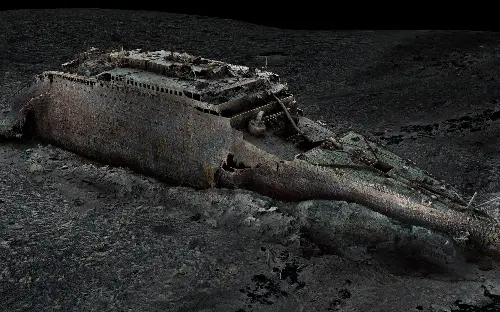
The Titanic sank with the lights still on as the ship’s crew remained at their posts to keep the electricity running, saving hundreds of lives, new images reveal.
A full-scale digital twin of the Titanic has been created by stitching together 715,000 images from underwater scans to recreate the stricken ship down to the last rivet.
It reveals a view of the boiler room showing that a steam valve was still open when the ship sank, proving for the first time that the engineers did not abandon ship but kept the power going to help passengers evacuate, and allow wireless distress signals to be sent.
“This is a line that was taking the remaining steam from the boiler room to the emergency dynamos,” said Captain Chris Hearne, a master mariner who has provided expert advice to the expedition.
“They provided life to the ship – the lighting, the heating and running the pumps.
“You could see this steam valve is clearly open which means steam was continuously flowing through the emergency dynamos. This action to keep this open saved hundreds of lives.”
The details have come to light in a National Geographic documentary which has spent two years analysing the data to reconstruct the ocean liner’s final moments.
The new model is so detailed that a video of it can be projected to life-size in a warehouse, so that researchers can walk inaccessible parts of the ship and observe individual features that are usually impossible to see.
Parks Stephenson, a Titanic analyst who worked on the reconstruction, said: “I’ve been (to the Titanic) in a submersible but I’ve only seen a little bit out of my viewport. When you are in a submersible, you can see maybe only a few metres in front of you.
“Now I have a better view of the Titanic than I ever did at the Titanic. To have the wreck site at my command to see what happened to the ship, the possibilities are endless.”
The Titanic struck an iceberg while making its maiden voyage just before midnight on April 14 1912, about 400 miles off Newfoundland, Canada, sinking a few hours later.
More than 1,500 of the 2,228 passengers and crew perished as the liner plunged into the deep.
The ship sank to the seabed, two and a half miles beneath the ocean surface and lies broken in two pieces, with the bow and stern about 2,600ft apart.
Debris from the disaster is scattered over a three by five-mile wreck site, but the digital scanning has allowed experts to piece the scattered hull fragments back together. It is so detailed that even the serial number on one of the propellers is visible.
It shows that the Titanic did not split cleanly in two, but it was violently torn apart, ripping through first-class cabins where prominent passengers like JJ Astor and Benjamin Guggenheim may have sought refuge as the ship went down.
A line of holes, around the size of an A4 sheet of paper, can be seen punched into the side of the hull, where it scraped against the iceberg.
A smashed porthole seen in the images suggest that ice did come into some people’s cabins, as witnesses claimed.
“First class passenger Margaret Swift saw the ice that had come from that porthole, that tells us that the iceberg was at least 30ft above the waterline,” said Dr Jennifer Hooper, materials scientist and author of What Really Sank the Titanic?
“So the scan is telling us the size of the iceberg. It’s definitely giving us information that will help us understand more about the collision that night.
“Seeing the Titanic wreck site in full scale and finally understanding how small I am in comparison to everything that I am looking at, I was able to truly experience the sense of destruction.”
The new images also exonerate William Murdoch, the Scottish first officer long accused of abandoning his post.
The upright position of a lifeboat davit – or crane – suggests his crew was preparing a launch moments before the Titanic dipped and the starboard side was engulfed, corroborating the testimony of Charles Lightoller, the second officer, that Murdoch was swept away by the sea while trying to help passengers escape.
The mystery of why the hull is still intact while the stern is shattered may also have finally been solved.
The team say scans suggest the back half of the ship spiralled down to the ocean floor where it disintegrated into pieces.
The Titanic has been extensively explored since the wreck was discovered in 1985 by oceanographer Robert Ballard but it has been difficult to get an overall picture because the deep ocean water is dark and cloudy so the whole site has never been seen until now.
In 2022, Magellan Ltd, a deep-sea mapping company joined forces with Atlantic Productions to use groundbreaking state-of-the-art techniques to finally see the whole picture.
Robotic submersibles, remotely controlled by a team on board a specialist ship, spent more than 200 hours surveying the length and breadth of the wreck.
As well as the ship itself, images of the 15-square-mile debris field have uncovered hundreds of personal artefacts, including pocket watches, purses, gold coins, hair combs, shoes and a shark’s tooth charm.
Titanic: The Digital Resurrection premieres on Monday April 15 at 8pm on National Geographic.
